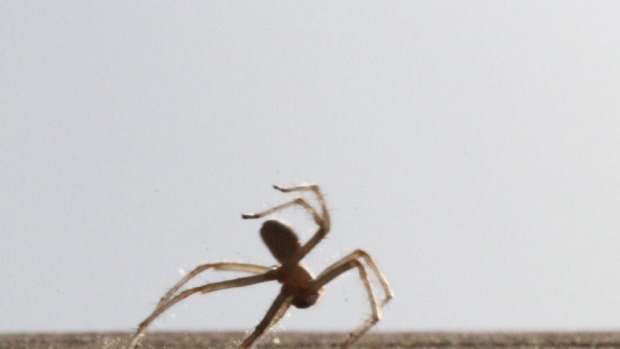Cebrennus rechenbergi runs for a short time, then stretches out its front legs, spinning into the air and returning to touch the ground with its hind legs. The move doubles the spider’s speed, to two meters per second. But since it uses so much energy, the maneuver is a last resort, called on only to escape predators.
“I can’t see any other reason,” said Peter Jäger, a taxonomist at the Senckenberg Research Institute and Natural History Museum in Frankfurt, Germany, who identified the spider. “It is a costly move. If it performs this five to 10 times within one day, then it dies.”
Cebrennus rechenbergi is the official name but Jäger has nicknamed it the flic-flac for the maneuver its leap resembles.

Cebrennus rechenbergi, the only spider known to move by means of flic-flac jump. Photo: Dr Rechenberg
The spider lives in a tubelike structure it weaves in the sand, staying hidden under a sandy lid and emerging at night in search of food.
At first Jäger mistook the spider for a sister species that lives in Tunisia and Algeria, but was able to distinguish the two through a close comparison of their copulatory organs.
Another arachnid, the golden rolling spider, exhibits a similar flipping behavior, but can only roll rapidly downhill, with the aid of gravity; the flic-flac spider can do its tumbling uphill, as well as on level ground and downhill. Although the newly discovered spider usually does its flips forward, it can do a backflip as well, Dr Jäger said, justifying its nickname, a gymnastics term for a back handspring.
The spider is named after Ingo Rechenberg, a bionics expert at the Technical University of Berlin. Rechenberg spotted the spider five years ago while taking an evening stroll (with a bright flashlight) in Erg Chebbi, a sand desert in south-eastern Morocco. He didn’t witness the rolling then, but instead took the unusual spider back to his caravan. In the morning when he witnessed the flic-flac behavior for the first time, he started crying.
“It was sensational,” he said.
Every year Rechenberg, 80, drives his caravan, outfitted with scientific equipment, from Germany via ferry to Morocco to study desert species and build robotic models based on their behavior. He has constructed a robot that mimics the flic-flac spider’s motions as well.
Robots struggle with moving over loose sand, and studying the spider could help solve this problem in an efficient way, Rechenberg said.
“I do my work in the desert where there is not much energy available,” he said. “That’s the reason I have gone every year for more than 30 years — to find out what the animals do to save energy.
Citation: Peter Jäger, 'Cebrennus Simon, 1880 (Araneae: Sparassidae): a revisionary up-date with the description of four new species and an updated identification key for all species', Zootaxa 3790 (2): 319–356 DOI:10.11646/zootaxa.3790.2.4




Comments